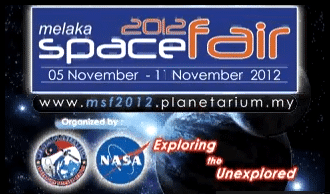Technology as a way to get kids hooked on science
 I hope that everyone is enjoying the new year! This is Rin, reporting in again after some more education-based travels. Last November I had the privilege of participating in another NASA international collaborative event. We traveled to Melaka, Malaysia for the second Melaka Planetarium Space Festival. The Melaka Planetarium is run by a small but ambitious group of passionate educators. The Planetarium sponsored nine NASA scientists and educators to bring workshops, demonstrations and activities aiming to encourage interest in space and earth sciences among elementary- and middle-schoolers.
I hope that everyone is enjoying the new year! This is Rin, reporting in again after some more education-based travels. Last November I had the privilege of participating in another NASA international collaborative event. We traveled to Melaka, Malaysia for the second Melaka Planetarium Space Festival. The Melaka Planetarium is run by a small but ambitious group of passionate educators. The Planetarium sponsored nine NASA scientists and educators to bring workshops, demonstrations and activities aiming to encourage interest in space and earth sciences among elementary- and middle-schoolers.
This time, as at previous space festivals, I witnessed some exciting applications of technology in the hands-on workshops. Paulo Younse of JPL brought a set of easily programmable robots, which students “taught” to navigate an obstacle course of a Martian landscape. Boys and girls of all ages find this activity exciting and challenging, and unwittingly learn the basics of programming.
Peter Falcon, also of JPL, brought a “magic planet” – a sphere-shaped screen that allowed students to visually see patterns and changes in a way that would be impossible out of a book. On this globe, students explored changing sea levels, being able to see the changes on a global level right before their eyes. They could also see temperature changes, cloud patterns, and many other aspects of earth science that are often difficult to grasp in the abstract. And it was beautiful! I know what I want for my birthday this year!

Another fantastic hands-on use of technology was arranged by Gabriel Alvarado from the SETI Institute. Mr. Alvarado wanted students and teachers alike to have access to real data and assist in actual scientific discovery. He brought this about by introducing festival-goers to PlanetHunters.org, a website where anyone can log on and view data from the Kepler mission, which searches for planets in other star systems. Users are trained in reading this data, and are then set loose to hunt for planets by looking for patterns in light output from far-away stars. Amateur astronomers all over the world examine the Keplar data, “tagging” stars that might have planets. When a star receives enough attention from amateur users, the Keplar scientists go in and examine the data as well. Just recently, a planet in a rare double binary star system was discovered in this way. The ability to access real data and participate in real science ignited the curiosity and excitement of many a festival-goer, child and adult alike.
Even with this astounding technology, the real motivators were the NASA team themselves. Every team member was overflowing with enthusiasm and energy, encouraging students to ask questions and find solutions to problems that they might not have ever considered before. I was honored to be included and hope to continue to work with this team in the future.
~Rin Scherrer